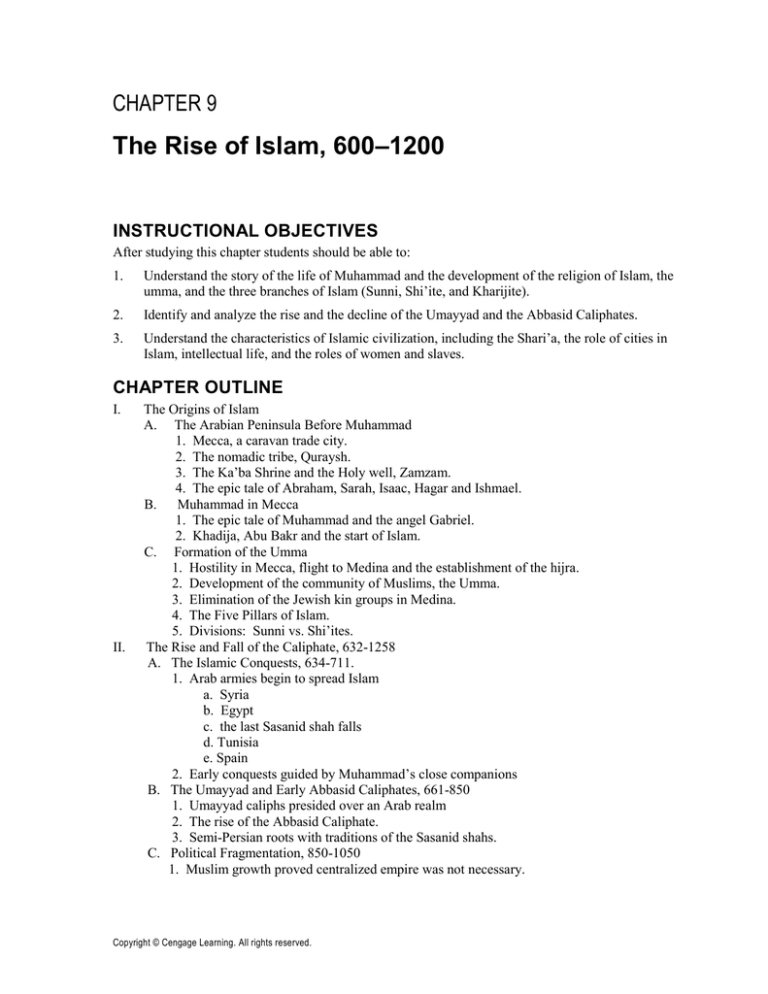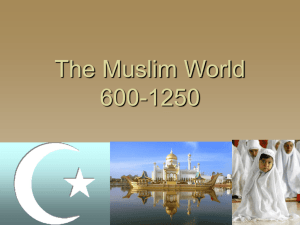
CHAPTER 9
The Rise of Islam, 600–1200
INSTRUCTIONAL OBJECTIVES
After studying this chapter students should be able to:
1.
Understand the story of the life of Muhammad and the development of the religion of Islam, the
umma, and the three branches of Islam (Sunni, Shi’ite, and Kharijite).
2.
Identify and analyze the rise and the decline of the Umayyad and the Abbasid Caliphates.
3.
Understand the characteristics of Islamic civilization, including the Shari’a, the role of cities in
Islam, intellectual life, and the roles of women and slaves.
CHAPTER OUTLINE
I.
II.
The Origins of Islam
A. The Arabian Peninsula Before Muhammad
1. Mecca, a caravan trade city.
2. The nomadic tribe, Quraysh.
3. The Ka’ba Shrine and the Holy well, Zamzam.
4. The epic tale of Abraham, Sarah, Isaac, Hagar and Ishmael.
B. Muhammad in Mecca
1. The epic tale of Muhammad and the angel Gabriel.
2. Khadija, Abu Bakr and the start of Islam.
C. Formation of the Umma
1. Hostility in Mecca, flight to Medina and the establishment of the hijra.
2. Development of the community of Muslims, the Umma.
3. Elimination of the Jewish kin groups in Medina.
4. The Five Pillars of Islam.
5. Divisions: Sunni vs. Shi’ites.
The Rise and Fall of the Caliphate, 632-1258
A. The Islamic Conquests, 634-711.
1. Arab armies begin to spread Islam
a. Syria
b. Egypt
c. the last Sasanid shah falls
d. Tunisia
e. Spain
2. Early conquests guided by Muhammad’s close companions
B. The Umayyad and Early Abbasid Caliphates, 661-850
1. Umayyad caliphs presided over an Arab realm
2. The rise of the Abbasid Caliphate.
3. Semi-Persian roots with traditions of the Sasanid shahs.
C. Political Fragmentation, 850-1050
1. Muslim growth proved centralized empire was not necessary.
Copyright © Cengage Learning. All rights reserved.
32
Chapter 9: The Rise of Islam, 600–1200
III.
2. Turkish slaves, mamluks, were purchased and made into an Islamic army.
3. Islamic conflicts throughout Northern Africa.
4. Islam moves into Spain.
D. Assault from Within and Without, 1050-1258
1. Seljuk Turks and the rise of the Sultan.
2. Lethal blow to the Byzantines at the Battle of Manzikert.
3. Christian Crusades to regain territories and Jerusalem taken by Islam.
4. Saladin.
5. Mongol invasions.
Islamic Civilization
A. Law and Dogma
1. Establishment of Shari’a.
2. The Hadith.
B. Converts and Cities
1. Not to convert placed an individual in an economic disadvantage.
2. Cities became heavily Muslim.
C. Women and Islam
1. Seclusion of women became commonplace in Muslim urban societies.
2. Allowed slavery but could not own another Muslim.
D. The Recentering of Islam
1. Muslim education: the madrasa
2. Sufi doctrine.
LECTURE TOPICS AND DISCUSSION QUESTIONS
The Origins of Islam
Lecture Topic: Muhammad in Mecca
Describe the epic tale of the life of Muhammad and the origins of Islam.
Discussion Questions:
1. What were the Muhammad’s relationships with the first converts to the Islamic faith?
2. What were Muhammad’s accusations toward the Christians and Jews and their faiths?
The Rise and Fall of the Caliphate, 632-1258
Lecture Topic: Islamic Conquests, 634-711
Describe how swift the Islamic religion conquered territory. Explain how this was viewed
as a threat to the regions surrounding the areas now converted into Islamic law.
Discussion Questions:
1. What reasons might there be for the timing, rapidity, and direction of Muslim territorial
expansion? What attempts were made to stop the spread of Islam?
2. Why did the Muslims force the non-Muslims to pay the taxes? Was this an effort to get
them to convert through economic hardship?
Copyright © Cengage Learning. All rights reserved.
Chapter 9: The Rise of Islam, 600–1200
Islamic Civilization
Lecture Topic: Law and Dogma
Explain the difference between a country that is Muslim in population vs. an Islamic State.
Discussion Questions:
1. To what extent can the adherence of Shari’a law govern the population?
2. What could be meant by the “sunna,” or the tradition of the prophet as the best guide in one’s
own actions? To what extent has it been followed?
ESSAY TOPICS
1.
Research the fate of the Jewish tribes in Medina.
2.
What was the reason why those who refused to convert were forced to pay taxes.
3.
Express and support your agreement or disagreement with the following statement: “Islamic
civilization in the Abbasid period valued religious dogma rather than the objective pursuit of
knowledge.”
4.
What were the status and the roles of Jews under Islamic rule?
INTERNET RESOURCES
The following Internet sites contain written and visual material appropriate for use with this chapter.
Princeton University—Maps Relating to Islam’s Historical Development
https://qed.princeton.edu/main/MG/Maps/Islam’s_Historical_Development
Journal of Religion & Society
http://moses.creighton.edu/JRS/2007/2007-29.html
Islamic Art at the Los Angeles County Museum of Art
http://www.lacma.org/islamic_art/intro.htm
PBS—Muhammad: Legacy of a Prophet
http://www.pbs.org/muhammad/
Copyright © Cengage Learning. All rights reserved.
33








